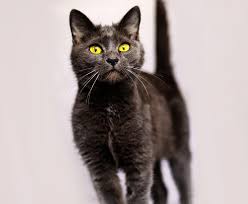
Russian White, Russian Black and Russian Tabby
Russian White
The Russian White was developed in the 1970s by a breeder named Frances McLeod in the United Kingdom. McLeod aimed to introduce a solid white coat to the Russian Blue lineage by crossing Russian Blues with white domestic cats. This effort created a cat with the same graceful features and affectionate temperament of the Russian Blue but with a pristine white coat. The breed was officially recognized by various cat associations in the 1980s.Russian Black and Russian Tabby
The Russian Black and Russian Tabby were developed around the same time as the Russian White, with similar goals of expanding the Russian Blue's coat colors. The Russian Black features a solid black coat, while the Russian Tabby exhibits classic tabby patterns. These variations were created by selectively breeding Russian Blues with other domestic cats that exhibited the desired coat colors and patterns, while maintaining the Russian Blue’s build and temperament. These color variations are less common than the traditional Russian Blue but are recognized by certain cat registries, particularly in Europe and Australia.Conditions of detention
Russian Whites, Blacks, and Tabbies thrive in calm, stable environments and prefer a quiet home where they can feel secure. They enjoy having cozy spots to relax and can adapt well to apartment living.
Useful Fact:
These Russian color variants are known for their gentle and reserved nature, making them ideal companions for quieter households. They form strong bonds with their human companions and are often affectionate and loyal once trust is established.
Nutrition and diet
Russian White, Russian Black, and Russian Tabby cats require a balanced diet that includes high-quality protein, healthy fats, and essential vitamins and minerals. It is important to provide them with both wet and dry food options to ensure they receive adequate hydration and dental care. Avoid feeding them human food, especially those high in salt, sugar, or fat.
Useful Fact: These cats have a relatively low-calorie requirement due to their moderate activity level, so it’s essential to monitor their food intake to prevent obesity.
Health
All three variations are generally healthy breeds with few genetic issues. Regular veterinary check-ups are crucial to monitor their health, especially for common feline issues like dental disease, obesity, and kidney problems.
Useful Fact: Russian Blue cats, including White, Black, and Tabby variations, are known for their longevity, often living up to 15 years or more with proper care.
Grooming and care
Despite their dense fur, these cats require minimal grooming. Weekly brushing helps to remove loose hairs and reduce shedding. Regular nail trimming, ear cleaning, and dental care are also important.
Useful Fact: Their short, dense coat is less likely to cause allergic reactions in humans, making them a better choice for allergy sufferers.
Education and training
Russian Blue cats, including the White, Black, and Tabby, are intelligent and can be trained to follow basic commands and use a litter box efficiently. Positive reinforcement techniques work best.
Useful Fact: They enjoy interactive toys and puzzle feeders, which stimulate their minds and keep them engaged.
Toys and entertainment
These cats enjoy a variety of toys, including feather wands, laser pointers, and interactive puzzle toys. Regular playtime helps to keep them mentally and physically stimulated.
Useful Fact: They particularly enjoy climbing and exploring, so providing cat trees or shelves can keep them entertained.
Safety
Ensure a safe environment by keeping hazardous materials out of reach and securing windows and balconies. These cats should ideally be kept indoors to protect them from outdoor dangers.
Useful Fact: Microchipping your cat can help in case they accidentally get lost, providing a reliable way to reunite with them.
Accessories
Essential accessories include a comfortable bed, scratching posts, and a variety of toys. A sturdy cat carrier is important for trips to the vet or when traveling.
Useful Fact: Investing in a high-quality scratching post can save your furniture and satisfy their natural scratching instincts.
Socialization
Russian White, Black, and Tabby cats are generally friendly and enjoy the company of their human family. Early socialization with different people and environments helps them become well-adjusted adults.
Useful Fact: They tend to form strong bonds with their owners and can sometimes be shy around strangers, so gentle and gradual introductions are best.
Travel and Transportation
When traveling, use a secure and comfortable cat carrier. Familiarize your cat with the carrier before trips to reduce stress. During travel, make frequent stops to check on their well-being if it’s a long journey.
Useful Fact: Bringing along familiar items like a favorite blanket or toy can help reduce anxiety during travel.
Behavior and psychology
When traveling, use a secure and comfortable cat carrier. Familiarize your cat with the carrier before trips to reduce stress. During travel, make frequent stops to check on their well-being if it’s a long journey.
Useful Fact: Bringing along familiar items like a favorite blanket or toy can help reduce anxiety during travel.
Legal aspects
Ensure your cat is up-to-date on vaccinations and registered as required by local regulations. Spaying or neutering your cat is recommended to prevent unwanted litters and reduce certain health risks.
Useful Fact: Many areas require cats to be microchipped and wear identification tags, which can help in reuniting lost pets with their owners.


